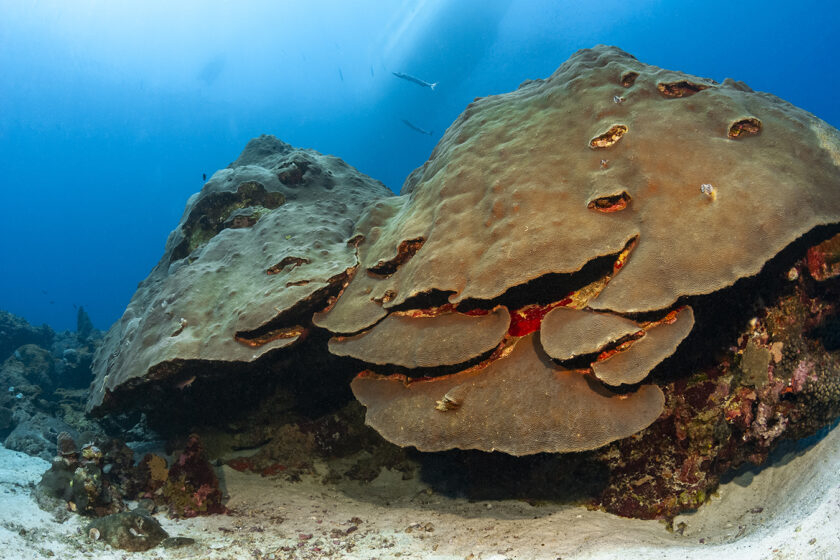Back in 2007, I was highly fortunate to be invited as part of special survey trip out to the Flower Garden Bank’s East and West Coral Cap formations. Intriguing part of this story is how vibrant and alive coral reef system such as this could possibly exist as it does in the most Northern part of the Gulf of Mexico.
Early morning, June 10th 2007 the trip started on a good note. Weather and water conditions in the Northern Gulf of Mexico can be mercurial – even in the milder summer months – but we’d enjoyed calm seas and almost no wind on our overnight passage aboard the 100-foot live-aboard M/V Fling.
By the early morning hours, the dive deck was a beehive of activity, with dive teams suiting up and receiving final briefings while gathering their various survey tools. It is the middle of June, and we have come to the underwater plateaus known as the Flower Garden Banks to perform an assessment of the reefs. The survey teams are working for PBS&J, a national consulting and Service Company that works in a number of professional arenas ranging from architecture and engineering to envirnemental survey. This week, they will be performing the latter service on behalf of NOAA’s National Marine Sanctuary Program and US Minerals Management Service (MMS).
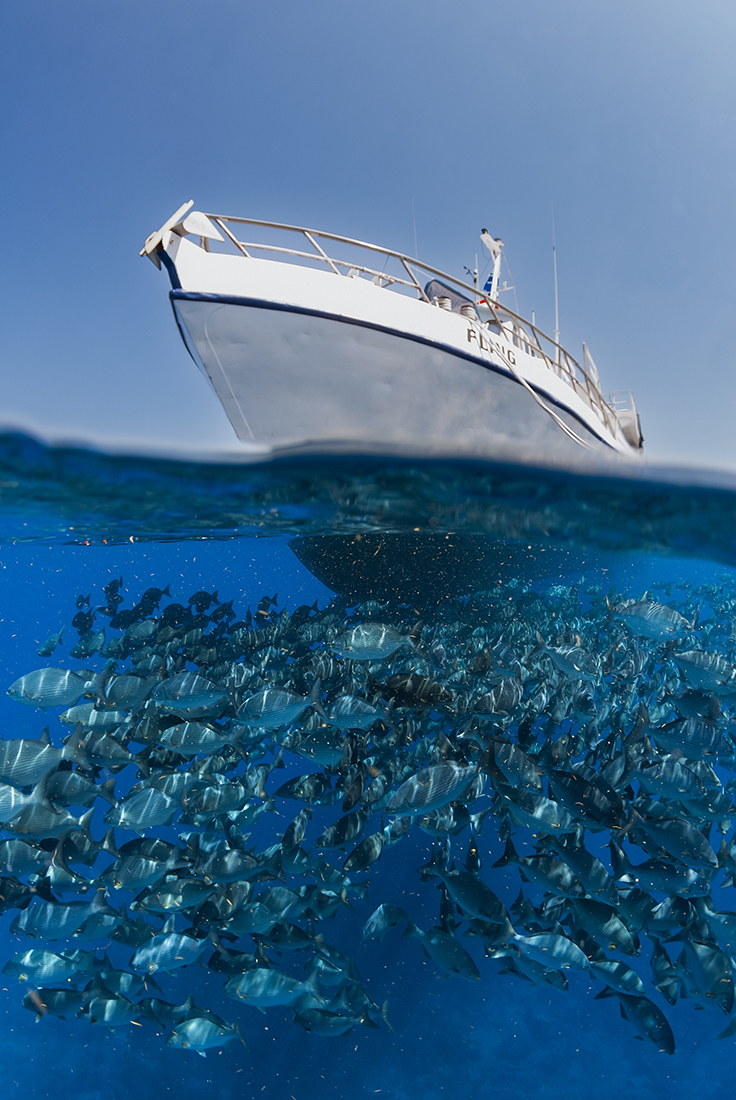
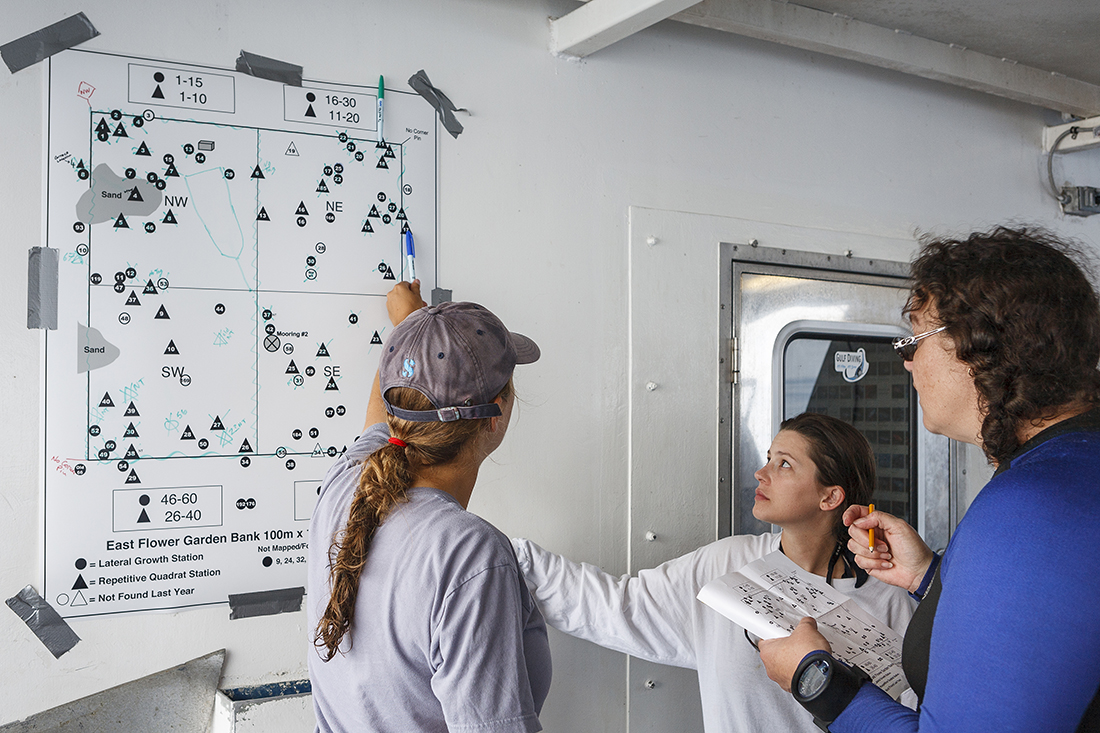
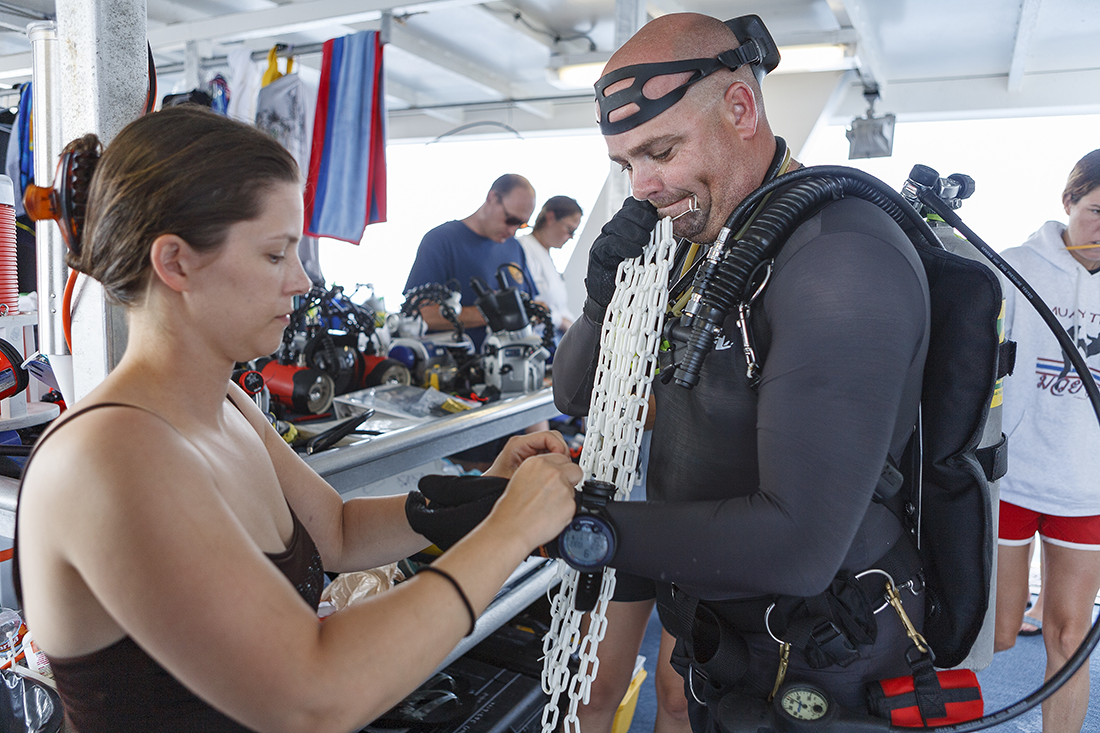
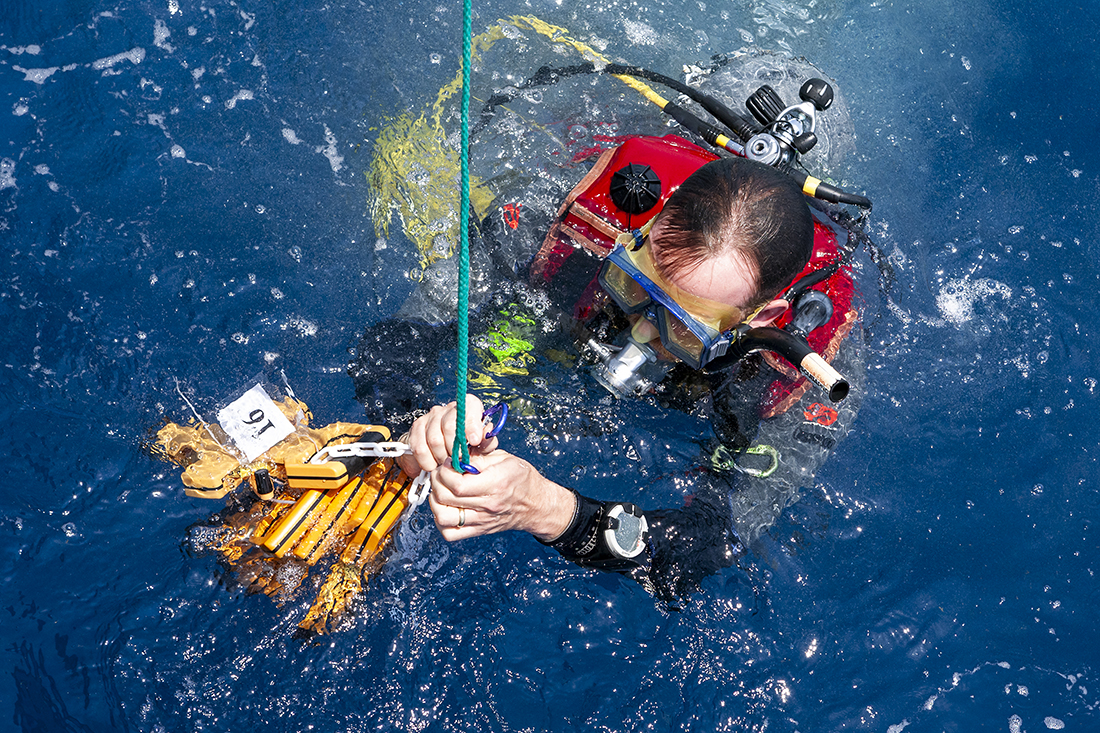
Following the first group down the ladder, I am pleasantly surprised to find underwater clarity that is conservatively in the 90 to 100-foot range. I’m shadowing Team One, which is made up of divers Adam Gelber, Ken Jones, and Dave Roberts. With rapid efficiency, they set to work placing the boundary lines for the 100-meter-square survey site that will be the focus of the week’s diving activity. This master grid is then sub-divided into four separate survey areas.

Additional survey teams soon arrive on the bottom – each moving to their assigned quadrant where they begin to systematically attach 18-inch white plastic chains to a series of numbered pins set into the coral. The highly buoyant nature and white coloration of these chains will make them easy targets to spot when the divers come back later to begin photographing the corals.

As the survey teams begin the methodical process of documenting the health and growth of the reef, I take a few minutes to conduct my own, less formal assessment of the underwater environment. In a 30-year diving career, I’ve visited quite a few reef systems through the Caribbean, Bahamas and Tropical Atlantic as far north as Bermuda, but I was seeing here had me stunned. Sixty feet beneath the surface was the healthiest Western Atlantic hard coral communities I’ve seen in quite some time.
There is no evidence of bleaching, yellow-blotch or black band disease. From top to bottom, the corals’ tissue coloration is consistent and indicative of healthy, active organisms. The most prolific species on the reef are Montastraea, or star corals as they are commonly called. If you are not sure what they look like, think of haystack shaped mounds, or the series of overlapping plates that you will see growing down the side of steep slope in the Florida Keys or Cayman Islands.

The second most dominate – and obvious – stand out is the variety of brain coral known as Diploria strigoas or Symmetrical Brain Coral (it is described in the Humann/Deloach book on Reef Coral Identification). It is a species I known well from travels in Bermuda, the Bahamas and Tobago. What I find most striking is the amount of live coral growth.
According to Biologist Martha Robbart, who oversees data collections and analysis for PBS&J, the live coral cover on the reef is (as of 2006) 51% (57.8% according to recent surveys conducted by the Atlantic and Gulf Rapid Reef Assessment (AGRRA).

By comparison, the live coral cover in the Florida Keys National Marine Sanctuary stands at 6%. Slightly lower than AGRRA’s 2003 survey report (J.C. Lang) of 10.8%. The health and vitality of the Flower Gardens’ corals is inspiring, but also somewhat enigmatic. How is it that these reefs can not only survive but also thrive in the northern Gulf of Mexico, just 115 miles south of Freeport Texas, and in the middle of the busiest offshore oil field in North America? This is one of the ongoing questions that survey teams such as ours one day hope to answer.
The Flower Gardens – Then & Now
The 1970’s were an important era for marine conservation. The fledgling ecological movement of the late ‘60s had solidified into a major national agenda, bringing with it a host of regional and national initiatives to increase the understanding of and protection for our natural resources On the Federal level, NOAA, through Congressional support enacted the Marine Protection, Research and Sanctuaries Act in 1972, establishing the National Marine Sanctuaries Program. In the same year, the Marine Mammals Protection Act and Coastal Zone Management Act were also passed.

Among the programs initiated by the Sanctuaries Act was the creation of the first ever marine sanctuary for the USS Monitor in January of 1975 and the Key Largo National Marine Sanctuary in December of the same year. After being passed up in 1979 and 1984, the Flower Garden banks was finally provided marine sanctuary status in 1992, making it the nation’s tenth in the list of 14 federally designated underwater areas under the protection of NOAA’s National Marine Sanctuary Program. Later in 1996, Stetson Bank was added as a third feature to the Flower Gardens Sanctuary.

Perhaps more than any other Sanctuary in the program, the Flower Garden Banks requires a vigilant monitoring and protection effort. During the past half century, the Northern Gulf of Mexico has grown into one of world’s largest marine drilling fields, with approximately 3,800 gas and oil platforms and pumping wells spread across its waters. From the upper deck of our dive boat, we could see 7 to 9 of these oil platforms on the horizon as we sat on the Flower Garden’s East Banks. The closest of these rigs, HI (abbreviation for High Island) A389A sits less than a mile away.
Amazingly, though they sit almost in the middle of all this oil activity, the Flower Garden East and West Banks have maintained high levels of healthy coral cover. For many years – even before the Flower Garden Banks was given Sanctuary status – there have been regular efforts to monitor the health of these reefs and assess any potential physical damage associated with oil and gas activities ranging from rig emplacement to potential toxic and smothering effects from drilling mud discharges. Although NOAA handles direct management of the Flower Garden Banks National Marine Sanctuary (FGBNMS), it is Minerals Management Service (MMS), a division of the U.S. Department of the Interior (USDOI), that regulates the oil and gas industries activities with regards to the Flower Gardens.

Initial monitoring programs began in the mid 1970s, consisting of the chemical analysis of bottom sediments taken from the vicinity of the platforms. These first efforts rapidly evolved into more comprehensive studies and monitoring programs of the Bank’s benthic ecosystem. Since 1974, MMS has stipulated that the petroleum industry operating in the Gulf must sponsor these various monitoring programs. Between the late ‘70s and ‘80s, MMS went as far as to mandate sponsoring of pre and post drilling surveys to determine what effects discharges were having on the nearby banks’ biosphere.
By the start of the ‘90s, monitoring programs in the FGBNMS evolved further with increased field study to assess the reef’s ecosystems stability or changes that maybe taking place. Today, the bulk of the fieldwork contracted by MMS and NOAA is executed by independent surveying and consulting companies such as PBS&J, which has held the contract since 2002.
Quantifying a Reef’s State of Health

By the end of the first dive, the teams had set the transect lines defining the survey site’s perimeter and four respective quadrants. Next, they began the painstaking task of relocating the lateral growth and repetitive quadrant stations that had been set in previous years. Ultimately, they would have to locate 100 metal pins, each the diameter of a pencil and some 4 to 16 inches high in a 100-meter square field of dense coral growth.
Though time consuming and somewhat tedious, this is the sort of work that forms the basis for a true coral assessment study. Simply swimming down to bottom, sweeping your eyes across the reef and saying ‘yeah the coral looks good… or bad this year” just doesn’t cut it. To accurately document a given reef’s state of health, individual coral head’s need to be monitored closely over a multiyear period, which includes measuring percent coral cover as well as rates of growth while and at the same time recording the presence of bleaching, disease or other maladies.

Most of the numbered station pins on the Flower Garden East and West Bank have been in place since 1992. Being able to track data over a 15-year period allows biologist to work from a historical baseline to create a more accurate assessment of the reef’s current state of health. Especially when factoring in periods of stress, as was the case during two periods in the 1990s. Most notably brought on by a summer water temperature that rose above 30°C/86°F, an increase in bleaching occurred in 1990, 1995, and again in 1997-1998, as well as 2005.
As most will recall, the summer of 2005 was the year of Hurricane Katrina and Rita. Prior to the two named storms, seawater temperatures in the Gulf of Mexico were again elevated to the very high ‘80s, providing the fuel needed to turn Katrina into a Category Five monster. The same season, coral bleaching was also observed by the FGBNMS research team at the Flower Garden Banks
Then on September 23, 2005, Hurricane Rita (a slightly smaller Category Three) passed within 50 miles (83 km) of the Flower Garden Banks. According to a report by Flower Garden Banks National Marine Sanctuary (FGBNMS) staff, damage from the storm included the dislodging of several large coral heads dislodged, with others gouged from waterborne projectiles, and various levels of scouring.


On another survey in November of 2005, of the East Bank survey site by PBS&J reported approximately 1.5 percent of the coral colonies photographed at the repetitive quadrant stations were missing. In addition to documenting the damaging effects of the hurricane’s storm surge, the survey found that the previous summer’s coral-bleaching event was ongoing and was at its highest level since the bleaching event of 1990. While evident in all coral species, the most impacted was the resident Montastraea cavernosa (great star coral) and Millepora alcicornis (branching fire coral), turning large portions of the affected heads white. Yet, oddly, post-bleaching mortality rates measured by PBS&J were no higher than .2% – 2.8% indicating that once the bleaching event was over, the coral colonies appeared to recover.

While three fifths of the PBS&J’s in water endeavors focuses on measuring and recording the condition of corals for the MMS Long Term Study reports, another two fifths of each survey’s focus is on the benthic community the corals support. Along with 21 species of Scleractinian (stony) corals, the banks support 23 known species of sponges and 280 species of fish like this tiger grouper (Mycteroperca tigris) pictured below.

Based on PBS&J’s 2004-2005 Long-Term Monitoring report for Minerals Management Service, coral cover on the Flower Garden’s East and West Banks was 57.1 percent for both banks and both years. These studies, along with the less scientific but very real assessment I was able to make with my own eyes provided a testament to the resiliency of a reef when conditions are right.
There are several factors that probably contribute to the health of the Flower Garden Banks coral reefs, but most agree that water quality is a key component. The location, some 115 miles from land, isolates from the damaging effects associated with contaminated run off. The coral cap formations atop the Flower Garden East and West Banks sit at depths below 60 feet, but with water clarity commonly in the 80-100 feet – light penetration for photosynthesizing organisms is ideal. Water temperatures range from 18°C in mid-February to 30°C in August but prevailing oceanic salinity conditions at the Flower Garden Banks remain in the realm of 34 to 36 ppt, which is also ideal for coral growth.
But water quality alone may not provide the entire answer. Not when similar sites in the Exuma Banks of the Bahamas – which enjoy almost identical water and light conditions – are having difficulty with bleaching, coral diseases, and evasive algae cover. Such anomalies demonstrate that there is still much to learn about coral growth and health. That is why studies such as those conducted each year at the Flower Garden Banks are so vital to our overall understanding of some of the smallest but most important animals in our oceans – the corals. Time may be running out for many reefs around the world, but the more we can learn about the ways in which these organisms thrive, suffer, and recover, the better the chance we may be able to reverse some of the current changes that affect us all.

